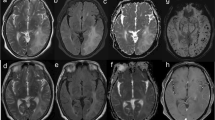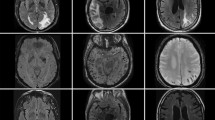Abstract
According to the modified Boston criteria, cerebral amyloid angiopathy (CAA) can present with lobar hematoma (LH) or superficial siderosis (SS). Recently, decreased CSF β-amyloid peptide 40 and 42 (Aβ40; Aβ42) and increased total and phosphorylated tau (t-tau; p-tau) concentrations have been described in CAA presenting with LH. Our aim was to analyze CSF biomarkers as a diagnostic tool for CAA according to the modified Boston criteria. We prospectively included patients with possible or probable CAA according to the modified Boston criteria. CSF was analyzed for t-tau, p-tau, Aβ42, and Aβ40. Data were compared with AD patients (n = 42) and controls (n = 14). Thirteen CAA patients were included, nine presenting with LH and four with SS. T-tau and p-tau levels in CAA were higher than controls, but lower than in AD. Differences in t-tau and p-tau levels between CAA versus controls and AD were all significant apart of the CAA p-tau levels comparison with controls. Aβ42 levels in CAA were significantly lower than in controls, and slightly higher than in AD, though non-significantly. Aβ40 levels in CAA were non-significantly lower than in controls, and significantly lower than in AD. Combining the findings of our study and the earlier report, we confirm that patients with suspected CAA have significantly different values for t-tau, Aβ42, Aβ42/t-tau, and Aβ40. Especially Aβ40 levels seem to be of clinical interest to differentiate CAA from AD. CSF biomarkers have to be analyzed in a larger number of CAA patients, and compared to patients with other disorders causing LH or SS.

Similar content being viewed by others
References
Knudsen KA, Rosand J, Karluk D, Greenberg SM (2001) Clinical diagnosis of cerebral amyloid angiopathy: validation of the Boston criteria. Neurology 56:537–539
Verbeek MM, Kremer BP, Rikkert MO et al (2009) Cerebrospinal fluid amyloid beta(40) is decreased in cerebral amyloid angiopathy. Ann Neurol 66:245–249
Hansson O, Zetterberg H, Buchhave P et al (2006) Association between CSF biomarkers and incipient Alzheimer’ disease in patients with mild cognitive impairment: a follow-up study. Lancet Neurol 5:228–234
Vemuri P, Wiste HJ, Weigand SD et al (2009) Alzheimer disease neuroimaging initiative. MRI and CSF biomarkers in normal, MCI, and AD subjects: diagnostic discrimination and cognitive correlations. Neurology 73:287–293
Goos JD, Teunissen CE, Veerhuis R et al. (2011) Microbleeds relate to altered amyloid-beta metabolism in Alzheimer’s disease. Neurobiol Aging 33:1011.e1–1011.e9
Linn J, Halpin A, Demearel P et al (2010) Prevalence of superficial siderosis in patients with cerebral amyloid angiopathy. Neurology 74:1346–1350
van Rooden S, van der Grond J, van den Boom R et al (2009) Descriptive analysis of the Boston criteria applied to a Dutch-type cerebral amyloid angiopathy population. Stroke 40:3022–3027
Bateman RJ, Munsell LY, Morris JC, Swarm R, Yarasheski KE, Holtzman DM (2006) Human amyloid-beta synthesis and clearance rates as measured in cerebrospinal fluid in vivo. Nat Med 12:856–861
Conover WJ (1999) Practical nonparametric statistics, 3rd edn. Wiley, New York
Bibl M, Mollenhauer B, Esselmann H et al (2006) CSF amyloid-beta-peptides in Alzheimer’s disease, dementia with Lewy bodies and Parkinson’s disease dementia. Brain 129:1177–1187
Pijnenburg YA, Schoonenboom SN, Mehta PD et al (2007) Decreased cerebrospinal fluid amyloid beta (1–40) levels in frontotemporal lobar degeneration. J Neurol Neurosurg Psychiatry 78:735–737
Gabelle A, Roche S, Gény C et al (2011) Decreased sAβPPβ, Aβ38, and Aβ40 cerebrospinal fluid levels in frontotemporal dementia. J Alzheimer Dis 26:553–563
Dubois B, Feldman HH, Jacova C et al (2007) Research criteria for the diagnosis of Alzheimer’s disease: revising the NINCDS-ADRDA criteria. Lancet Neurol 6:734–746
Hernandez-Guillamon M, Delgado P, Penalba A et al. (2012) Plasma β-amyloid levels in cerebral amyloid angiopathy-associated hemorrhagic stroke. Neurodegener Dis 10:320–323
Acknowledgments
A.G. has received funding for travel expenses for AD conferences from Novartis.
Conflicts of interest
There are no other conflicts of interest to report for any of the authors.
Author information
Authors and Affiliations
Corresponding author
Rights and permissions
About this article
Cite this article
Renard, D., Castelnovo, G., Wacongne, A. et al. Interest of CSF biomarker analysis in possible cerebral amyloid angiopathy cases defined by the modified Boston criteria. J Neurol 259, 2429–2433 (2012). https://doi.org/10.1007/s00415-012-6520-8
Received:
Revised:
Accepted:
Published:
Issue Date:
DOI: https://doi.org/10.1007/s00415-012-6520-8




